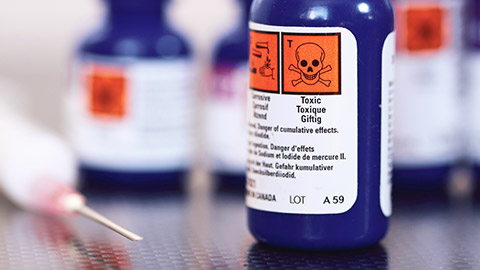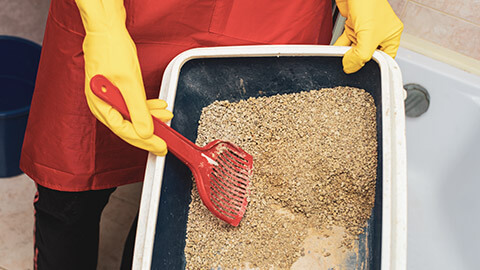There are many different types of hazards and risks associated with the animal care industry. The severity of the hazard or risk can also change depending on the specific circumstances. In addition to hazards that come from animals, there are also environmental and resource hazards and risks associated with the animal care sector.
The following table illustrates some examples of environmental hazards, their causes and associated risks that may be present in an animal care facility. Some suggestions as to how to reduce or eliminate the hazards are also provided.
| Environmental or resource hazard | Causes | Risks | How to reduce the risk or hazard |
|---|---|---|---|
| Air pollution / Poor air quality |
|
|
|
| Biohazards |
|
|
|
| Chemicals (including fumes) | Inappropriate use and disposal of animal treatment products, cleaning agents and other chemicals. | Accidental exposure to humans and or animals could result in:
|
|

Safe use of chemicals and cleaning agents is an essential element of an environmentally sustainable workplace as well as part of an effective occupational health and safety program within any organisation.
Each state or territory has a code of practice for the safe storage, handling, use and disposal of chemicals in the workplace. You must follow those guidelines. Using correct procedures in controlling the exposures to chemical agents will require a careful process of hazard recognition and risk assessment to reduce or eliminate any risk of unnecessary exposure.
There are many hazardous chemicals, medications and cleaning agents that are used in animal handling practices. There are also various physical consequences that are a result of misuse or overuse of these hazardous substances. The following table outlines some common hazardous products in animal care workplaces and the consequences that may result from their misuse or overuse.
| Type of hazardous substance | Outcomes of misuse or overuse |
|---|---|
| Animal medications and anaesthetics |
|
Cleaning products including:
|
|
Failure to comply with the correct handling techniques can lead to long-term exposure. Some of these chemicals, if you are exposed to long-term, can have serious effects such as cancers, due to carcinogenic factors.
All organisations must carry Safety Data Sheets (SDS). SDS are documents that are provided by manufacturers, which:
- provide information about the health and safety concerns for the products
- identify any substances or chemicals that are classified as hazardous substances or dangerous goods
- describe the specific properties of the chemicals and how they may affect the health of people using them.
Examine the MSD Animal Health Safety Data Sheet (pdf) to get an idea of what type of information an SDS holds.
All chemicals and cleaning agents must be stored and labelled as per the state or territory's legislation and guidelines. For example, there are several drugs and medications that must be kept in a locked container at a veterinary clinic and may only be issued by a prescribed person, in this case, the veterinarian or vet nurse.
Make sure that when you are handling any chemical or cleaning agent that you use the appropriate personal protective equipment (PPE). For example, you may be required to wear gloves and a face mask.

Animal waste has the potential to cause harm by acting as pathological (disease-causing) waste while decomposing. Hazardous waste products in an animal care facility include:
- Animal bodies that are not infectious or contaminated
- Used animal litter and food products that are infectious or contaminated
- Faeces that are not infectious or contaminated
- Discharges of blood or blood products.
So, when dealing with waste products and soiled bedding it is vital that you wear the correct PPE, and you determine if the animal is classed as contagious or non-contagious before you begin.
In Victoria, the Environment Protection Authority (EPA) regulates the storage, transport, treatment and disposal of clinical and related wastes under the Environment Protection (Industrial Waste Resource) Regulations 2009. Guidance for generators of clinical and related wastes can be found in Part C of the document, ‘Clinical and related waste’. Each state and territory will have their own regulations.
Regulations relating to the disposal of hazardous waste, including animal waste, are also covered by the National Guidelines for Waste Management in the Healthcare Industry.
Waste disposal in animal care
When the time comes to dispose of waste in your workplace, it is important to understand what you must do for each type of waste product. Let’s take a look at the following three examples of waste products:
- Litter and faeces
- Used bedding
- Contagious animals
Litter and faeces
Waste products such as litter and faeces must be placed:
- into a hazardous waste plastic bag
- in a cool storage area until collected by an approved licensed removal company.
Cat faeces is particularly hazardous for pregnant women. So, pregnant women should avoid handling or disposing of this type of waste product wherever possible.
Used bedding
All bedding that is not too badly soiled will need to be placed into the washing machine and cleaned with washing powder.
All used bedding needs to be washed separately from other laundry items, such as uniforms, to avoid cross-contamination.
Contagious animals
Animals diagnosed with contagious diseases must be kept in an isolation ward (ISO-W). Animals that are in isolation MUST have ALL bedding, waste products and used PPE disposed of into hazardous waste plastic bags, labelled “Contagious waste”.
Contagious waste must be destroyed accordingly – cremated or collected by the hazardous waste removal specialist. This is particularly important because some of these contagions can survive on surfaces and continue to spread.
Waste management procedures
A good example of a private company that deals with biohazardous waste from the animal care industry is the Australian business, Waster Pty Ltd. The following video (2:50 min) outlines Waster’s clinical waste collection service, which could apply to a veterinary clinic.
Waster also provides general advice, such as the benefits of conducting a waste audit as shown in the following video (2:55 min), as well as advice about best-practice waste management for some specific animal care workplaces, such as ‘Disposal of Waste In A Dog Grooming Salon’. The NSW Animal Welfare Code of Practice 8 outlines specific cleaning and waste disposal practices in Section 5, Hygiene, which must be followed in this type of workplace.
Knowledge check
Complete the following questions.

